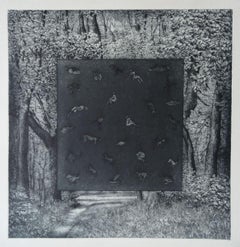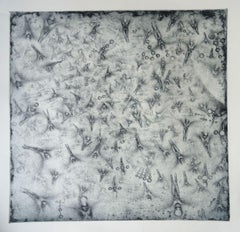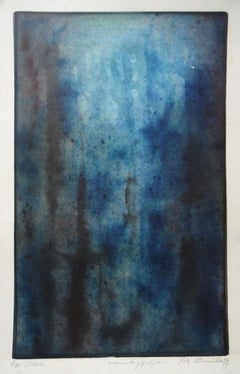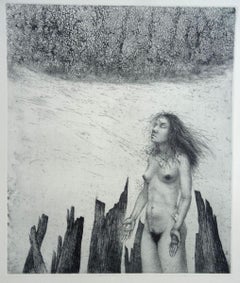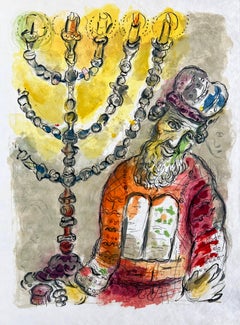Symbolist Art
to
241
553
93
142
44
59
Overall Width
to
Overall Height
to
1
101
626
166
22
103
111
92
13
13
23
18
48
12
100,808
57,664
51,636
25,326
12,362
8,522
5,915
5,474
4,077
2,790
2,056
1,853
1,833
666
578
248
53
536
331
224
176
165
107
94
55
45
45
38
38
33
30
25
25
21
20
19
19
254
191
155
146
110
96
42
38
37
34
107
432
534
200
Style: Symbolist
Returnable Items Only
Green frame. Paper, etching, aquatint, 43x42 cm
Located in Riga, LV
Nele Zirnite (1959)
2003 Associate Professor, Art Department, the Latvian Christian Academy
2000 M.F.A., the Latvian Art Academy
1995 – 2003 Lecturer, Graphic Arts Department...
Category
1990s Symbolist Art
Materials
Paper, Etching
XXX Paper, etching, 50x52 cm
Located in Riga, LV
Nele Zirnite (1959)
2003 Associate Professor, Art Department, the Latvian Christian Academy
2000 M.F.A., the Latvian Art Academy
1995 – 2003 Lecturer, Graphic Arts Department...
Category
1990s Symbolist Art
Materials
Paper, Etching
Flowers 1999, Paper, monotype
Located in Riga, LV
Nele Zirnite (1959)
2003 Associate Professor, Art Department, the Latvian Christian Academy
2000 M.F.A., the Latvian Art Academy
1995 – 2003 Lecturer, Graphic Arts Department...
Category
1990s Symbolist Art
Materials
Paper, Etching
Origin Paper, etching, 42x36 cm
Located in Riga, LV
Nele Zirnite (1959)
2003 Associate Professor, Art Department, the Latvian Christian Academy
2000 M.F.A., the Latvian Art Academy
1995 – 2003 Lecturer, Graphic Arts Department...
Category
2010s Symbolist Art
Materials
Paper, Etching
Elegant Women in a Park - Original lithograph, 1898
By Manuel Robbe
Located in Paris, IDF
Manuel ROBBE
Elegant Women in a Park, 1898
Original lithograph (Champenois workshop)
Printed signature in the plate
On vellum, 40 x 31 cm (c. 16 x 12 in)
INFORMATION: Lithograph cr...
Category
1890s Symbolist Art
Materials
Lithograph
Thou shalt also anoint Aaron and his sonnes, and shalt... - The Exodus
By Marc Chagall
Located in OPOLE, PL
This work will be exhibited at Art on Paper NYC, September 4–7, 2025.
–
Marc Chagall (1887-1985) - Thou shalt also anoint Aaron and his sonnes, and shalt consecrate them, that they...
Category
1960s Symbolist Art
Materials
Lithograph
$6,136 Sale Price
20% Off
Melancolic Seascape with Sailboats - Original Lithograph, 1898
Located in Paris, IDF
Francis JOURDAIN
Melancolic Seascape with Sailboats, 1898
Original lithograph (Champenois workshop)
Printed signature in the plate
On vellum, 40 x 31 cm (c. 16 x 12 in)
INFORMATION...
Category
1890s Symbolist Art
Materials
Lithograph
Young Girl Playing in the Woods - Original lithograph, 1898
Located in Paris, IDF
Eugene DELATRE
Young Girl Playing in the Woods, 1898
Original lithograph (Champenois workshop)
Printed signature in the plate
On vellum, 40 x 31 cm (c. 16 x 12 in)
INFORMATION: Lit...
Category
1890s Symbolist Art
Materials
Lithograph
Young Girl with an Orange - Original lithograph, 1898
Located in Paris, IDF
Louise BRESLAU
Young Girl with an Orange, 1898
Original lithograph (Champenois workshop)
Printed signature in the plate
On vellum, 40 x 31 cm (c. 16 x 12 in)
INFORMATION: Lithograp...
Category
1890s Symbolist Art
Materials
Lithograph
Forellenweiher - Etching and Drypoint by Franz Von Stuck - 1890s
Located in Roma, IT
Forellenweiher is a wonderful black and white etching and drypoint on wide rod cream paper realized by Franz von Stuck in 1890-1891.
Hand signed in gr...
Category
1890s Symbolist Art
Materials
Paper, Drypoint, Etching
Kampf - Vintage Héliogravure by Franz von Bayros - 1921 ca.
Located in Roma, IT
Kampf is a very beautiful black and white héliogravure on cream-colored cardboard realized by Choisy Le Conin, as is remembered Franz Von Bayros (Agram, 1866 – Vienna, 1924).
From M...
Category
1920s Symbolist Art
Materials
Engraving
Menashe Kadishman, Sheep head 39, Acrylic on canvas
Located in Tel Aviv, IL
Menashe Kadishman, Sheep head, Symbolist painting, colored painting, Israeli art, Israeli art
Category
1980s Symbolist Art
Materials
Acrylic
Mein Weg mit dem Weib #13 - Original Etching by W.R. Rehn
Located in Roma, IT
Drypoint and aquatint (brown ink) on cream paper.
Signed "Rehn" in pencil on the lower right margin. Titled and numbered in pencil on the lower left margin. Edition of 25 prints. Fr...
Category
1910s Symbolist Art
Materials
Drypoint, Aquatint
Shepherd - Etching by A. Suares - 1926
Located in Roma, IT
Shepherd is from Illustrations for Cressidra, a print on paper realized by André Suares in 1926.
Etching and drypoint
Edition of 200 print, Including a Passepartout
Good conditions.
Category
1920s Symbolist Art
Materials
Drypoint, Etching
Der Zeichner - Etching by Unknown Artist of circle of Max Klinger
Located in Roma, IT
Der Zeichner is a superb etching made around 1900 by a still unknown author, but surely from the circle of Max Klinger (Leipzig, 1857 - Grossjena, 1920).
Title on plate in the lower margin in the center. Posthumous impression of a matrix by an unknown author.
The style refers to the Griffelkunst and the prescriptions of the Max Klinger "school of stylus"and of the artists who were close to him. In particular, for the subject in question, in the circle of Max Klinger, Saschia Schneider stands out, who placed male...
Category
Early 1900s Symbolist Art
Materials
Etching
Der Philosoph - Etching by Max Klinger - 1885
By Max Klinger
Located in Roma, IT
Image dimension cm 29.7x19.9.
Printed in the lower margin, center: «Max Klinger / Der Philisoph / (Aus «Vom Tode, II») / Pan I 2».
Engraving from the art periodical Pan, vol. I, no...
Category
1880s Symbolist Art
Materials
Etching
Le Sire De Lumey
Located in Middletown, NY
Brussels: J. Bouwens, 1867. Etching with aquatint and engraving on laid Japan paper, 9 3/4 x 6 1/2 inches (247 x 163 mm), full margins. Fifth state (of 5). Scattered moderate foxing....
Category
Late 19th Century Symbolist Art
Materials
Laid Paper, Engraving, Etching, Aquatint
Still life with flounder
Located in Riga, LV
Nele Zirnite (1959)
2003 Associate Professor, Art Department, the Latvian Christian Academy
2000 M.F.A., the Latvian Art Academy
1995 – 2003 Lecturer, Graphic Arts Department...
Category
Early 2000s Symbolist Art
Materials
Paper, Etching
Carousel 2001, 4/50, paper, etching, 6.5x6 cm
Located in Riga, LV
Nele Zirnite (1959)
2003 Associate Professor, Art Department, the Latvian Christian Academy
2000 M.F.A., the Latvian Art Academy
1995 – 2003 Lecturer, Graphic Arts Department...
Category
Early 2000s Symbolist Art
Materials
Paper, Etching
On the edge 2010. 1/50. A/P. Paper, etching, aquatint
Located in Riga, LV
Nele Zirnite (1959)
2003 Associate Professor, Art Department, the Latvian Christian Academy
2000 M.F.A., the Latvian Art Academy
1995 – 2003 Lecturer, Graphic Arts Department...
Category
2010s Symbolist Art
Materials
Paper, Etching
André Eugène Costilhes (1865-1940) Portrait of a young woman, drawing
Located in Paris, FR
André Eugène Costilhes (1865-1940)
Portrait of a young woman
pencil on paper
30.5 x 20 cm
In quite good condition Traces of folding in the upper left-hand corner. Lower right corn...
Category
Early 1900s Symbolist Art
Materials
Pencil
Living Caryatids - Oil Painting by Marco Rossati - 1985 ca.
By Marco Rossati
Located in Roma, IT
Beautiful and impressive painting by Marco Rossati, showing his interest for Classicism as well as for esotericism.
Through a fine painting technique Rossati retrieves the values of ...
Category
1980s Symbolist Art
Materials
Oil
Kraft und Mut (Courage and Strength), German antique engraving
Located in Melbourne, Victoria
'Kraft und Mut'
(Courage and Strength)
German wood-engraving, 1903.
320mm by 230mm (image)
280mm by 410mm (sheet)
Category
Early 20th Century Symbolist Art
Materials
Engraving
Bowl of Fruits by Fernand Blondin - Oil on Canvas - 55x46 cm
Located in Geneva, CH
Fernand Blondin (1887-1967) was a Swiss painter and teacher, celebrated for his depictions of idyllic rural life, interiors, female nudes, portraits, still-lifes, religious subjects ...
Category
Mid-20th Century Symbolist Art
Materials
Canvas, Oil
Cosmic Travelers - Visionary Psychedelic Composition on Wood Panel
Located in Soquel, CA
Cosmic Travelers - Visionary Psychedelic Composition on Wood Panel
Surreal, psychedelic composition by an unknown artist (20th Century). The face on the left side of the composition...
Category
21st Century and Contemporary Symbolist Art
Materials
Acrylic, Wood Panel
Brahms-Phantasie - Rare Portfolio of 41 Engravings by Max Klinger - 1894
By Max Klinger
Located in Roma, IT
Brahms-Phantasie is a wonderful in-folio volume: the Brahm's Phantasies musical score is incredibly illustrated with 37 numbered plates for a total of 41 original engravings (burin, ...
Category
1890s Symbolist Art
Materials
Paper, Engraving
Then the Angel of the Lorde appeared unto him in a flame of fire... - The Exodus
By Marc Chagall
Located in OPOLE, PL
Marc Chagall (1887-1985) - Then the Angel of the Lorde appeared unto him in a flame of fire, out of the middes of a bush; and he looked, and beholde, the bush was not consumed
Litho...
Category
1960s Symbolist Art
Materials
Lithograph
Simplicius' Writing Lesson from Intermezzi - Etching by Max Klinger - 1881
By Max Klinger
Located in Roma, IT
Simplicius' Writing Lesson (Simplici Schreibstunde) (plate VII) belongs to a series of prints called Intermezzi realized by Max Klinger, published by Nurnberg: Stroefer, 1881.
Etchi...
Category
1880s Symbolist Art
Materials
Etching
Pursued Centaur (Verfolgter Centaur) - Etching by Max Klinger - 1881
By Max Klinger
Located in Roma, IT
Pursued Centaur (Verfolgter Centaur) belongs to a series of prints called Intermezzi realized by Max Klinger, published by Nurnberg: Stroefer, 1881.
Etching on paper.
Signed on the...
Category
1880s Symbolist Art
Materials
Etching
$991 Sale Price
30% Off
Dramatic Storm over Sandhamn, Sweden, 1943
Located in Stockholm, SE
This striking seascape, painted in 1943 by Jacob Löfgren, most likely depicts a view from Sandhamn, a location he frequently captured in his works. Four years earlier, he created ano...
Category
1940s Symbolist Art
Materials
Oil, Board
$4,153 Sale Price
20% Off
Musik und Danz (Music and Dance), after Eduard Veith, German antique engraving
By Eduard Veith
Located in Melbourne, Victoria
'Musik und Danz'
(Music and Dance)
German wood-engraving, circa 1895.
Central vertical fold as issued.
Eduard Veith was an Austrian portrait painter and stage designer. Many o...
Category
1890s Symbolist Art
Materials
Engraving
20th Century British School - Symbolist pastel drawing of a Coastal Landscape
Located in London, GB
BRITISH SCHOOL
(20th Century)
Coastal Landscape with White Cliffs
Signed with monogram l.r.
Pastel on paper
Framed
18.5 by 10 cm., 7 ¼ by 4 in.
(frame size 39.5 by 30 cm., 15 ½ by...
Category
Mid-20th Century Symbolist Art
Materials
Pastel
Frederick Cayley Robinson - A Summer Evening - British oil on paper
Located in London, GB
FREDERICK CAYLEY ROBINSON, ARA, RWS
(1862-1927)
A Summer Evening
Signed l.r.: CAYLEY-ROBINSON; inscribed on the reverse: A Summer Evening/Exhibited at Leicester Galleries
Oil on paper
16.5 by 18.5 cm., 6 ½ by 7 ¼ in.
(frame size 38.5 by 40 cm., 15 ¼ by 15 ¾ in.)
Exhibited:
London, Leicester Galleries, Small Paintings and Sketches by the Late F. Cayley Robinson, ARA, RWS, December 1929
Born in Brentford-on-Thames, the son of a stockbroker, Robinson began his artistic training at the St John’s Wood...
Category
Early 1900s Symbolist Art
Materials
Oil
"War and Peace", Silent Requiem Broken Stone and Doves Original Oil Painting
By Andrée Bars
Located in Clermont-Ferrand, Auvergne-Rhône-Alpes
“War and Peace” is an original oil painting on linen by Andrée Bars.
In warm sandstone tones, ranging from ochre beige to dusty brown, this powerful composition stages a moment of t...
Category
2010s Symbolist Art
Materials
Oil
Untitled (Mother and Child)
Located in Myrtle Beach, SC
Maurice Denis, Untitled (Mother and Child), lithograph, 1897, edition not stated. Signed in the stone, lower right. Annotated in linotype 'MAURICE DENIS, ORIGINAL LITHOGRAPHIE PAN III' in the lower left sheet corner. A fine, atmospheric impression, in warm, dark gray ink, on buff wove paper, with full margins (2 1/2 to 1 3/4 inches); a small discoloration in the bottom left sheet corner, otherwise in good condition. Image size 8 5/8 x 6 7/8 inches; sheet size 13 7/8 x 10 5/8 inches. As published in 'Pan', the leading German magazine of the period devoted to art and literature. Matted to museum standards, unframed.
Collection: Los Angeles County Museum of Art.
Reproduced: German Expressionist Prints...
Category
1890s Symbolist Art
Materials
Lithograph
Opus IV, Simplicius in der Waldeinode - Etching by Max Klinger - 1881
By Max Klinger
Located in Roma, IT
Opus IV, Simplicius in der Waldeinode (Simplicius in the Wilderness) belongs to a series of prints called Intermezzi realized by Max Klinger, published by Nurnberg: Stroefer, 1881.
...
Category
1880s Symbolist Art
Materials
Etching
Pegase Captif - after Odilon Redon - 1923
By Odilon Redon
Located in Roma, IT
Pegase Captif is a prototype reproduction realized after Odilon Redon.
They belong to the suite "Odilon Redon Peintre, Dessinateur et Graveur", published by Henri Felury in 1923.
...
Category
1920s Symbolist Art
Materials
Photogravure
'Le Paradis Terrestre' (Paradise on Earth) — French Symbolism
Located in Myrtle Beach, SC
Edouard Goerg, 'Le Paradis Terrestre' (Paradise on Earth), etching, 1931, edition 40. Signed, titled, and numbered '3/40' in pencil. A fine richly-inked impression, on heavy, cream w...
Category
1930s Symbolist Art
Materials
Etching
Portrait de Jeune Fille Portrait of a Girl 1970 original aquatint Leonor Fini
By Leonor Fini
Located in Paonia, CO
Portrait de Jeune Fille is a haunting portrait of a young girl also known as .. Justine… she could be either fading into the distance or just materializing out of a dream state. Her hair and the air around her is in shades of pale blue and the background is the white of the paper. This is a limited edition ( 170/300) aquatint , signed in the plate. In good condition with a 1" repaired tear midway on the right border which will not show when framed.
Argentinian-born artist Leonor Fini (1907-1996) is considered one of the great female artists of the twentieth century. She moved to Paris in the early 1930’s where she spent most of her life and almost immediately formed friendships with Salvador Dali, Cartier- Bresson, Max Ernst and other intellectuals of the time. At twenty five she had her first one person show in Paris and was included in the 1936 pivotal exhibition at MOMA…Fantastic Art, Dada and Surrealism…..and that same year had an exhibition at a famous avant garde gallery in New York. Although Fini never considered herself a Surrealist she maintained close personal relationships with several members of the group. One can see how their ideology influenced her work but she remained firmly rooted in the tradition of Symbolism, Metaphysics and Italian and German Romanticism Her works can be found in most important collections of modern art around the world.
Fini was renowned as a portraitist and as a painter of erotic sexual tensions with a mysterious atmosphere. She was adamant about being independent and not belonging to any one group. She lived life on her own terms and is sometimes referred to as …..the female Dali. She was also involved with designing for fashion and creating elaborate sets for opera and theatre. As a feminist she was definitely ahead of the times. She produced the first erotic male nude...
Category
20th Century Symbolist Art
Materials
Aquatint
Evening in the Mountains by Joseph André Mussler - Oil on Wood - 45x45 cm
Located in Geneva, CH
Joseph André Mussler (1904-1980) was a Swiss painter known for his works depicting natural landscapes, often focusing on scenes from the Alps, such as mountain valleys and alpine hut...
Category
Mid-20th Century Symbolist Art
Materials
Wood, Oil
Ex Libris Doctor Turis Lustig - Etching by Michel Fingesten - 1930s
Located in Roma, IT
Ex Libris Doctor Turis Lustig is an etching realized by Michel Fingesten in 1930s.
30x24 cm. it includes passpartout.
Handigned in the lower right part.
Good conditions.
Michel ...
Category
1930s Symbolist Art
Materials
Etching
Ange Déchu - Lithograph after Odilon Redon - 1923
By Odilon Redon
Located in Roma, IT
Ange Déchu is a prototype reproduction realized after Odilon Redon.
They belong to the suite "Odilon Redon Peintre, Dessinateur et Graveur", published by Henri Felury in 1923.
Tit...
Category
1920s Symbolist Art
Materials
Lithograph
"Moon Set" - Original Oil on Canvas
Located in Soquel, CA
"Moon Set" - Original Oil on Canvas
Original oil painting titled "Moon Set" by Bay Area artist Jeffrey Burchell. Hues of purples and blues take up the canvas, with the moon serving ...
Category
20th Century Symbolist Art
Materials
Oil
Illustration from the series "Les Fleurs du Mal" after Odilon Redon - 1923
By Odilon Redon
Located in Roma, IT
Illustration from the series "Les Fleurs du Mal" is an etching print realized after Odilon Redon and published by Henri Felury in 1923.
Monogrammed on the plate.
Good conditions.
...
Category
1920s Symbolist Art
Materials
Lithograph
Sogno di Oro (Golden Dream) - Symbolist Figurative Painting in Blue and Gold
Located in New York, NY
Gregory Kitterle's Sogno di Oro (Golden Dream) is a 39 x 50 inch horizontal figurative symbolist painting on canvas. This work brings the viewer in a magical setting of lapis lazuli ...
Category
2010s Symbolist Art
Materials
Oil, Canvas
Le Masque de la Mort Rouge - Lithograph after Odilon Redon - 1923
By Odilon Redon
Located in Roma, IT
Le Masque de la Mort Rouge is a phototype reproduction realized after Odilon Redon.
They belong to the suite "Odilon Redon Peintre, Dessinateur et Graveur", published by Henri Felu...
Category
1920s Symbolist Art
Materials
Lithograph
Menashe Kadishman, Sheep head , Acrylic on canvas
Located in Tel Aviv, IL
Menashe Kadishman, Sheep head, Symbolist painting, colored painting, Israeli art, Israeli art
Category
1980s Symbolist Art
Materials
Acrylic
Weddigen - Vintage Héliogravure by Franz von Bayros - Early 20th Century
Located in Roma, IT
"Weddigen" is an original Black and white héliogravure on cream-colored cardboard realized by Choisy Le Conin, pseudonym of Franz Von Bayros (Agram, 1866 – Vienna, 1924).
From Mappe...
Category
Early 20th Century Symbolist Art
Materials
Engraving
Menashe Kadishman, Sheep head 37, Acrylic on canvas
Located in Tel Aviv, IL
Menashe Kadishman, Sheep head, Symbolist painting, colored painting, Israeli art, Israeli art
Category
1980s Symbolist Art
Materials
Acrylic
Reclining Nudes in Landscape, signed oil painting
Located in Cirencester, Gloucestershire
Nudes in Landscape
German School, second half 20th century
indistinctly signed lower right
oil painting on board, framed
framed size: 33 x 41 inches
Superb large scale German oil p...
Category
Late 20th Century Symbolist Art
Materials
Oil
$3,758 Sale Price
30% Off
Ex Libris - Arnaldo Pescatore - Woodcut by Michel Fingesten - 1930s
Located in Roma, IT
Ex Libris Arnaldo Pescatore- is a woodcut print created by Michel Fingesten.
Hand Signed on the lower right margin.
Good conditions.
Michel Fingesten (1884 - 1943) was a Czech...
Category
1930s Symbolist Art
Materials
Woodcut
Suzanne Benton, Heavenly Kingdom, 2022, oil on Belle Art primed panel, Transcend
Located in Darien, CT
In this ninth decade of life, and as a working artist for nearly70 years, Suzanne Benton has become interested in the concept of Late Style as described by the literary theorist Edwa...
Category
2010s Symbolist Art
Materials
Oil
Hercules and the Lion (Apologies to Rubens) classical image, male figure
By Tom Bennett
Located in Brooklyn, NY
An expressionist homage to Rubens. Active, colorful take on an allegorical painting based on Greek Mythology. Active movement, aggressive brush strokes combine for a powerful and mil...
Category
2010s Symbolist Art
Materials
Oil
He wrote in the Tables the wordes of the covenant, even the Ten Commandments
By Marc Chagall
Located in OPOLE, PL
This work will be exhibited at Art on Paper NYC, September 4–7, 2025.
–
Marc Chagall (1887-1985) - He wrote in the Tables the wordes of the covenant, even the Ten Commandments
Li...
Category
1960s Symbolist Art
Materials
Lithograph
$1,793 Sale Price
20% Off
Fallen Rider - Etching by Max Klinger - 1881
By Max Klinger
Located in Roma, IT
Fallen Rider is a modern artwork realized by Max Klinger in 1881.
The artwork belongs to a series of prints called Intermezzi realized by Max Klinger, published by Nurnberg: Stroef...
Category
1880s Symbolist Art
Materials
Etching
Future Self - Surrealist Fantasy Portrait in Acrylic on Canvas
Located in Soquel, CA
Future Self - Surrealist Fantasy Portrait in Acrylic on Canvas
Bold surrealist portrait by California artist Joff Jones (American, b. 1992). A human-like figure is wearing a gas mas...
Category
2010s Symbolist Art
Materials
Canvas, Acrylic, Stretcher Bars
Kampfende Faune - Etching by Franz von Stuck - Early 20th Century
Located in Roma, IT
Kampfende Faune is an artwork realized by Franz von Stuck in the early 20th Century.
Etching.
Category
Early 20th Century Symbolist Art
Materials
Etching
Simplicius at the Hermit's Grave - Etching by Max Klinger - 1881
By Max Klinger
Located in Roma, IT
Simplicius at the Hermit's Grave- Simplicius am Grabe des Einsiedlers (plate VIII) belongs to a series of prints called Intermezzi realized by Max Klinger, published by Nurnberg: Str...
Category
1880s Symbolist Art
Materials
Etching
Love, Death and the Beyond - Etching by Max Klinger - 1881
By Max Klinger
Located in Roma, IT
Running Death from Intermezzi belongs to a series of prints called Intermezzi realized by Max Klinger, published by Nurnberg: Stroefer, 1881.
Etching on paper.
Signed and dated on ...
Category
1880s Symbolist Art
Materials
Etching
French School of the Early 20th Century - Female Nude Preparing Her Chignon
Located in Paris, Île-de-France
French School of the Early 20th Century
Female Nude Preparing Her Chignon
Pencil on paper, 60.5 x 40 cm
Dated 1906 lower right
Unsigned
Provenance:
Private collection
This delica...
Category
Early 20th Century Symbolist Art
Materials
Pencil
Symbolist art for sale on 1stDibs.
Find a wide variety of authentic Symbolist art available for sale on 1stDibs. Works in this style were very popular during the 21st Century and Contemporary, but contemporary artists have continued to produce works inspired by this movement. If you’re looking to add art created in this style to introduce contrast in an otherwise neutral space in your home, the works available on 1stDibs include elements of orange, blue, green, red and other colors. Many Pop art paintings were created by popular artists on 1stDibs, including Michel Fingesten, Abel Pann, Franz von Bayros (Choisi Le Conin), and Ferdinand Hodler & R. Piper & Co.. Frequently made by artists working with Paint, and Oil Paint and other materials, all of these pieces for sale are unique and have attracted attention over the years. Not every interior allows for large Symbolist art, so small editions measuring 1.58 inches across are also available. Prices for art made by famous or emerging artists can differ depending on medium, time period and other attributes. On 1stDibs, the price for these items starts at $55 and tops out at $378,675, while the average work sells for $863.
Recently Viewed
View AllMore Ways To Browse
Mauritz Lindstrom
Maximillien Luce
Michael Budden Central Park
Midcentury Matador Paintings
Mike Wright
Miracle On Ice
Mississippi River Painting
Monarch Of The Glen Painting
Moroccan Paintings Essaouira
Morpho Butterfly Art
Mount Tamalpais
Murray Dessner
Native American Oklahoma
New England Barn
New Orleans Jazz Poster
Niagara Falls Oil
Oil Painting By Alice
Oil Painting Willow Tree
